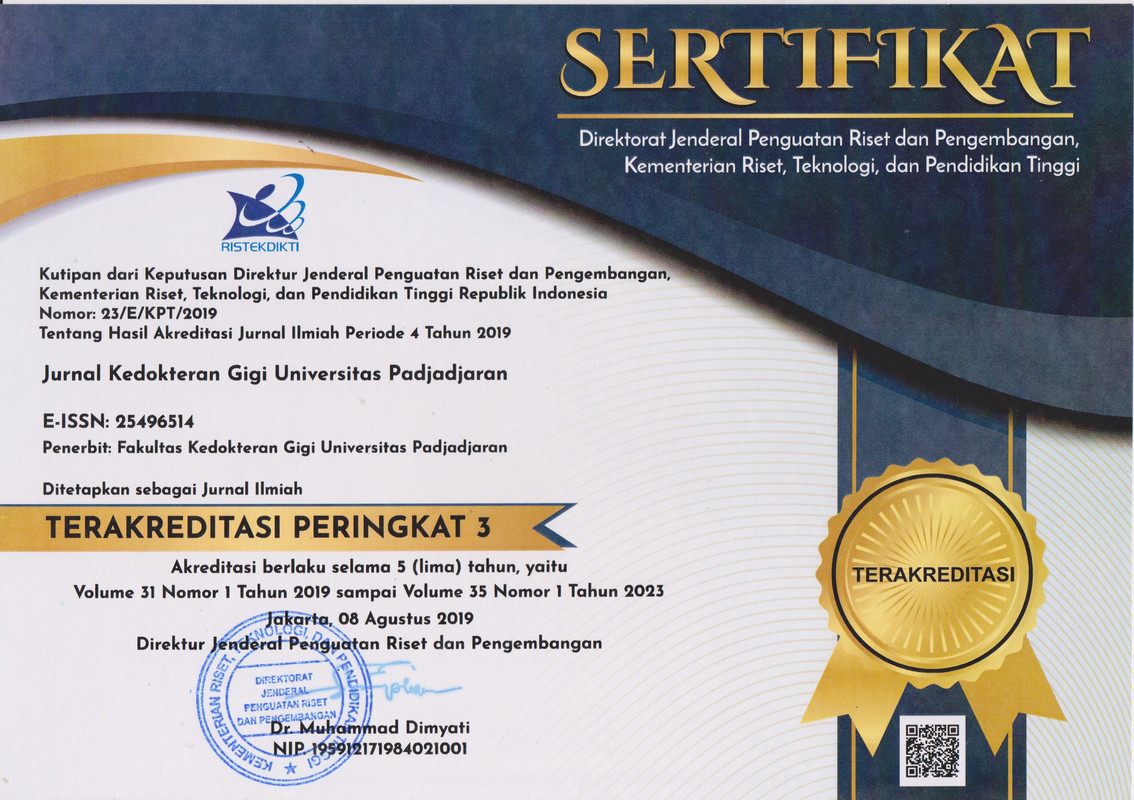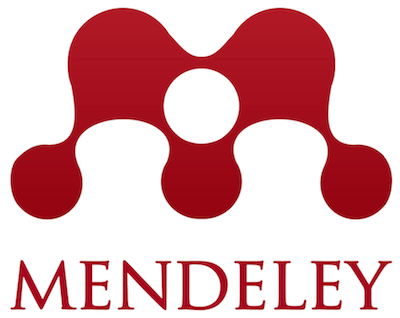Perbedaan efek penambahan hidroksiapatit pada bahan basis gigi tiruan resin akrilik polimerisasi panas terhadap kekerasan permukaan: studi eksperimental laboratoris
Abstract
Pendahuluan: Bahan basis gigi tiruan yang paling sering digunakan adalah resin akrilik polimerisasi panas (RAPP), namun RAPP memiliki kekerasan permukaan yang rendah sehingga mudah terjadinya abrasi. Abrasi dapat menjadi tempat penumpukan debris dan mikroorganisme. Kekerasan permukaan dapat ditingkatkan dengan menambahkan hidroksiapatit. Hidroksiapatit berikatan secara mekanis dan mengisi celah dalam matriks polimer. Tujuan penelitian ini untuk menganalisis perbedaan efek penambahan hidroksiapatit pada bahan basis gigi tiruan RAPP terhadap kekerasan permukaan. Metode: Rancangan penelitian ini adalah eksperimental laboratoris dengan desain posttest-only control group design. Sampel yang digunakan yaitu RAPP berukuran 30x5 mm (ISO 1567:1999) sebanyak 45 sampel yang terdiri dari 5 kelompok yaitu kelompok kontrol, kelompok penambahan hidroksiapatit 2%, 3%, 4% dan 5%. Setiap sampel diuji dengan Vicker Hardness Tester untuk mengetahui nilai kekerasan permukaan. Hasil: Hasil uji oneway-ANOVA menunjukkan adanya pengaruh penambahan hidroksiapatit 2%, 3%, 4% dan 5% pada bahan basis gigi tiruan RAPP terhadap kekerasan permukaan dengan nilai p=0,001 (p<0,05). Pada hasil uji LSD terlihat perbedaan bermakna terhadap kekerasan permukaan antara kelompok kontrol dengan kelompok penambahan hidroksiapatit 2%, 3%, 4% dan 5% serta pada setiap kelompok penambahan hidroksiapatit 2%, 3%, 4% dan 5% dengan nilai p=0,001 (p<0,05). Simpulan: Basis gigi tiruan RAPP dengan penambahan hidroksiapatit 2%, 3%, 4% dan 5% memiliki nilai diatas nilai standar kekerasan permukaan RAPP (15-18 VHN) dengan nilai tertinggi pada penambahan hidroksiapatit 5% sehingga hidroksiapatit dapat dimanfaatkan sebagai bahan penguat pada basis gigi tiruan RAPP untuk mencegah terjadinya abrasi yang dapat menjadi tempat perlekatan mikroorganisme.
The Effect of hydroxyapatite addition on surface hardness in heat-cured acrylic resin denture base material: a experimental laboratory
Introduction: The most prevalent denture base material is heat-polymerized acrylic resin (HCAR), however, HCAR exhibits low surface hardness and is susceptible to abrasion. Abrasion facilitates the accumulation of debris and microorganisms. The surface hardness can be enhanced through the addition of hydroxyapatite Hydroxyapatite Mechanically binds in the polymer matrix. The purpose of this study was to analyze the effect of adding hydroxyapatite to HCAR denture base material on surface hardness. Method: The design of this study was an experimental laboratory with post-test only control group design. The samples used were 45 HCAR samples-sized 30x5 mm (ISO 1567:1999) consisting of 5 groups: control group, hydroxyapatite addition of 2%, 3%, 4% and 5%. Each sample tested using Vicker Hardness Tester to determine the surface hardness value. Results: The results of oneway-ANOVA test showed the effect of adding 2%, 3%, 4% and 5% hydroxyapatite to the HCAR denture base material on surface hardness with value p=0.001 (p<0.05). The LSD test showed significant differences in surface hardness between the control group and the 2%, 3%, 4% and 5% hydroxyapatite addition groups and in each group of 2%, 3%, 4% and 5% hydroxyapatite addition with value p=0.001 (p<0.05). Conclusion: The HCAR denture base with the addition of 2%, 3%, 4% and 5% hydroxyapatite has values above standard value of HCAR surface hardness (15-18 VHN) with the highest value at 5% hydroxyapatite so hydroxyapatite can be utilized as reinforcing material of HCAR denture base to prevent abrasion which which causes microorganism attachment.
Keywords
Full Text:
PDFReferences
Nugrahini S. Perubahan warna pada plat gigi tiruan resin akrilik polimerisasi panas setelah perendaman dalam larutan desinfektan. SONDE (Sound of Dentistry). 2020;5(1):24.
Adytha A. Rangkuman Materi Prostodonsia untuk calon dokter gigi. Yogyakarta: Deepublish Publisher. 2020. p. 7.
Setyowati O, Wahjuni S, Sujati. pattern of demand for making dentures at dental laboratory In Surabaya City, Indonesia. J Vocational Health Studies. 2019;3(1):1-5. https://doi.org/10.20473/jvhs.V3.I1.2019.1-5
Carr AB, Brown DT. McCracken’s Removable Partial Prosthodontic. 13TH ed. Canada; Elsevier; 2016. p. 103-14.
Hadianto E, Firdausy MD. Non-dental glass fiber impact on tensile strength of fiber reinforced acrylic resin in denture base. Media Dent Intelektual J. 2022;4(1):91-6. https://doi.org/10.30659/medali.4.3.41-44
Manappallil JJ. Basic Dental Materials. 4th ed. John J Manappallil, editor. Basic Dental Materials. New Delhi: Reprint Jaypee Brothers MedicalPublishers (P) Ltd; 2024. p. 531–568.
Kenneth J. Anusavice, Chiayi Shen HRR. Phillips’ Science of Dental Materials. 13th ed. Elsevier, editor. 2021. p. 73–103, 143-170, 721–758.
Miftahullaila M, Sinamo S, Setiawan S. Pengaruh perendaman basis gigi tiruan resin akrilik polimerisasi panas dalam perasan murni bawang putih (Allium sativum L.) terhadap kekerasan permukaan. Prima J Oral Dental Scie. 2021;4(2):45-8. https://doi.org/10.34012/primajods.v4i2.2478
McCabe JF, Walls AW. Applied Dental Materials. 9th ed. Jakarta: EGC; 2017.
Porwal A, Khandelwal M, Punia V, Sharma V. Effect of denture cleansers on color stability, surface roughness, and hardness of different denture base resins. J Indian Prosthodont Soc. 2017;17(1):61–7. https://doi.org/10.4103/0972-4052.197940
Duymus ZY, Ozdogan A, Ulu H, Ozbayram O. Evaluation the Vickers Hardness of Denture Base Materials. Open J Stomatol. 2016;06(04):114–9. https://doi.org/10.4236/ojst.2016.64014
Wu H, Dave F, Mokhtari M, Ali MM, Sherlock R, McIlhagger A, et al. On the application of vickers micro hardness testing to isotactic polypropylene. Polymers (Basel). 2022;14(9):1804. DOI : 10.3390/polym14091804
Ory MD, Putranti DT. Pengaruh penambahan aluminium oksida pada bahan basis gigi tiruan resin akrilik polimerisasi panas terhadap kekerasan dan kekasaran permukaan. B-dent: J Ked Gigi Univ Baiturrahmah. 2019;6(1):1-6. https://doi.org/10.33854/jbd.v6i1.202
Abdullah ZS. The effect of addition of hydroxyapatite microscopic fillers on surface roughness and some mechanical properties of heat cured acrylic resin. J Bagh Coll Dentistry. 2015;27(3):50-4.
Sawada M, Sridhar K, Kanda Y. Pure hydroxyapatite synthesis originating from amorphous calcium carbonate. Sci Rep. 2021 ; 1 – 2. https://doi.org/10.1038/s41598-021-91064-y
Akhtar K, Pervez C, Zubair N, Khalid H. Calcium hydroxyapatite nanoparticles as a reinforcement filler in dental resin nanocomposite. J Mater Sci Mater Med. 2021;32(10). https://doi.org/10.1007/s10856-021-06599-3
Dorozhkin, Sergey V. Calcium orthophosphates (CaPO4): occurrence and properties. Progress in biomaterials. 2016;(5):9-70. https://doi.org/10.1007/s40204-015-0045-z
Nikolaev AL, Gopin AV, Severin AV, Rudin VN, Mironov MA, Dezhkunov NV. Ultrasonic synthesis of hydroxyapatite in non-cavitation and cavitation modes. Ultrason Sonochem. 2018 Jun;44:390-397. https://doi.org/10.1016/j.ultsonch.2018.02.047
Chondro RT, Kusumawardani CDN, Sari RP. Efectivity of adding hydroxypatite for reducing porosity on heat cured acrylic resin base. Denta. 2019;13(2):37–42.
Abduljabbar. Evaluation of the impact of nano and micro-hydroxyapatite particles on the transverse strength and hardness of PMMA material. AIP Conference Proceedings. 2024;3097(1). https://doi.org/10.1063/5.0209493
Afrizal. Analisa struktur mikro material substitusi hidroksiapatit cangkang kerang darah dan resin akrilik bahan pembuat gigi untuk aplikasi gigi tiruan. Surya Tenika J. 2016;1(4):1-9. https://doi.org/10.37859/jst.v2i04.17
Karadi RH, Hussein BMA. Effect of modified nanohydroxyapatite fillers addition on some properties of heat cured acrylic denture base materials. 2017;29(2):49-54. https://doi.org/10.12816/0038749
Kusumawardani CDN, Chondro RT, Andrian I, Sari RP. Pengaruh penambahan hidroksiapatit terhadap porositas dan compressive strength basis resin akrilik heat-cured. Effect of hydroxyapatite addition towards porosity level and compressive strength of heat-cured acrylic resin base. Jurnal Kedokteran Gigi Unpad. 2020;91-7. https://doi.org/10.24198/jkg.v32i2.26627
Imam DNA, Purnama NB, Kurniawan. The Effect of Addition of Blood Cockles (Anadara granosa) Shell Nano-hydroxyapatite on Hardness of Heat Cured Acrylic Resin. Jenderal Soedirman Internat Medic Conference 2020:237-39. https://doi.org/10.5220/0010490602370240
Kiran. of Processing Techniques on Microhardness and Impact Strength of Conventional and Reinforced Heat Cured Acrylic Resin: A Comparative Study. MATERIALE PLASTICE. 2021;58:239-246. https://doi.org/10.37358/MP.21.3.5521
Bajunaid SO. How Effective Are Antimicrobial Agents on Preventing the Adhesion of Candida albicans to Denture Base Acrylic Resin Materials? A Systematic Review. Polymers (Basel). 2022;14(5):908. https://doi.org/10.3390/polym14050908
DOI: https://doi.org/10.24198/jkg.v37i1.60110
Refbacks
- There are currently no refbacks.
Copyright (c) 2025 Jurnal Kedokteran Gigi Universitas Padjadjaran
INDEXING & PARTNERSHIP

Jurnal Kedokteran Gigi Universitas Padjadjaran dilisensikan di bawah Creative Commons Attribution 4.0 International License






.png)
















